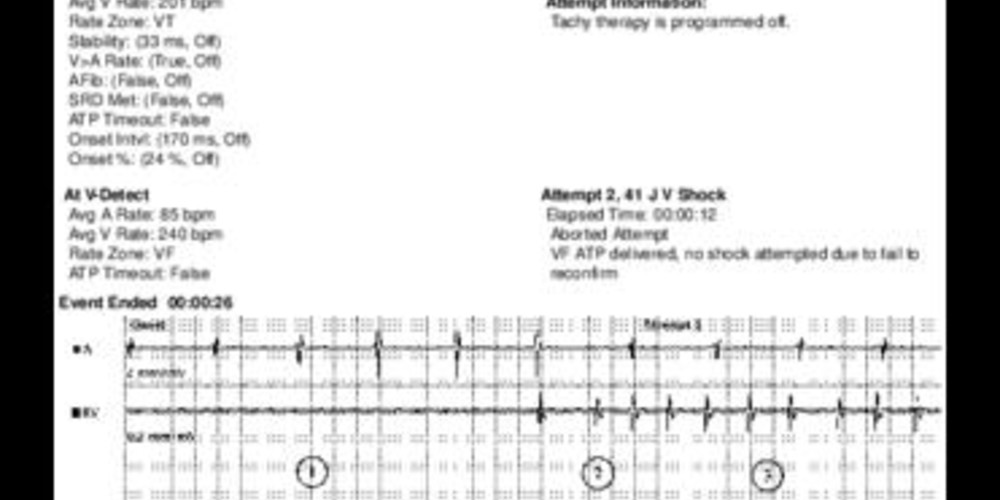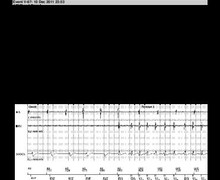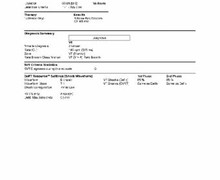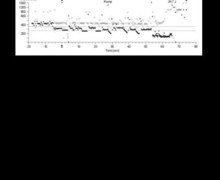Quick Convert ATP delivered in the VF zone
Tracing
Manufacturer Boston Scientific
Device ICD
Field Therapy
N° 4
Patient
This 63-year-old man presenting with severe dilated cardiomyopathy underwent implantation of a Boston Science Cognis triple chamber defibrillator for primary prevention. Multiple arrhythmic episodes diagnosed in the VF zone were treated by ATP.
Summary
An arrhythmic episode at 201 bpm was initially detected in the VT zone, programmed as a monitor only (tachy therapy de-activated), explaining the absence of treatment delivery. However, the arrhythmia, which subsequently accelerated to 240 bpm, was then detected in the VF zone, and a sequence of ATP was delivered.

Graph and trace
Tracing
- atrial sensing and biventricular stimulation;
- late VES;
- organized VT (AV dissociation) detected in the VT zone (VT);
- V-Epsd: episode of VT (8 out of 10 criterion fulfilled);
- diagnosis of VT (V-Detect) without programming of discrimination parameter; since the VT zone was programmed as monitor only, no therapy was delivered;
- acceleration of the tachycardia now detected in the VF zone;
- initial detection fulfilled for the VF zone (8 out of 10 cycles were in the VF zone); onset of initial 1-sec Duration for the VF zone;
- detection of an episode of VF (V-Detect); the ventricular rate measured from the average of 4 cycles preceding the V-Detect marker was <250 bpm;
- Quick Convert ATP: burst of 8 stimuli at a fixed rate (identical coupling between the last detected and the first paced cycles, then between the subsequent stimuli); the 220-ms cycle length of biventricular stimulation was the shortest programmable;
- the first atrial and ventricular cycles following ATP were not counted;
- the device analyzed the outcome of the ATP sequence: the first 2 cycles were analyzed as long (RVS); the 2 out of 3 long cycles criterion was, therefore, fulfilled and the charge of the capacitors was cancelled;
- end of episode.
Other articles that may be of interest to you







This tracing illustrates the power of the Quick Convert algorithm to pace-terminate organized ventricular arrhythmias detected in the VF zone. This ATP sequence can only be delivered after an initial detection in the VF zone, as long as the rate of the tachycardia is ≤250 bpm. The characteristics of this ATP sequence are not programmable, consisting of a burst of 8 stimuli at a cycle length equivalent to 88% of the tachycardia cycle length and a shortest stimulation cycle length of 220 ms. Thereafter, the device examined the efficacy of the therapy. If ≥2 out of 3 cycles were diagnosed as long, the charge was cancelled. Conversely, if ≥ 2 out of 3 cycles were diagnosed as short, the charge of the capacitors began. In this patient, termination of the VT without delivering a shock was an obvious advantage, and a major improvement from the perspective of his quality of life. Furthermore, the cancellation of the capacitors’ charge spared the batteries. On the hand, had ATP been unsuccessful, the onset of the charge would have been delayed by 2 to 3 seconds.